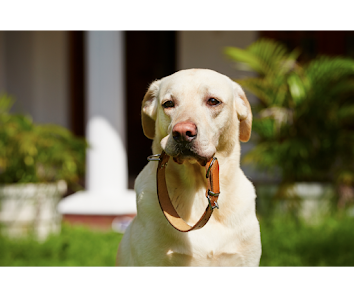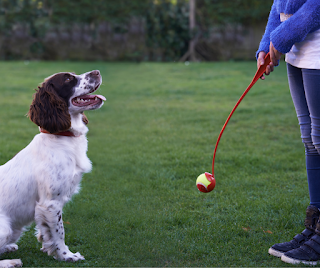How Can I Protect My Dog's Joints?
How Can I Protect My Dog's Joints?
There is lots of advice out there for dogs that have already been diagnosed with joint conditions and how we can make their life more comfortable. However, something that is often overlooked is how to look after and protect your dog's joints from an early age. By the time they have been diagnosed with a joint condition, it is often too late for you to prevent any future issues, as the joint has already been affected.
So, here we will look at ways you can protect your dog's joint health and hopefully lessen the chances of them developing more serious issues later in life. While some joint conditions can be genetic, or be more common among specific breeds, there are still steps you can take to try and keep their joints in optimal health:
Consider Using A Magnetic Collar
I personally have had great success using magnetic collars with my own dogs. All of my dogs wear a magnetic collar permanently, especially during their later years. They're relatively cheap to purchase and are very long-lasting (We have had some for almost 10 years, and they're still effective and wearable)
Magnetic collars are designed to encourage blood flow around your dog's body and promote their natural healing process. They are often used in sporting and high-activity working dogs but can be worn by any dog. Companies also offer coats and wraps, which can be worn to stimulate blood flow around the whole body, or in specific areas of concern.
Although there is no scientific proof of the effectiveness of magnets yet, there are lots of testimonies from owners which suggest they work! (me included!) There are even human magnetic products available, to support your health and joints as well, so you could see the benefits for yourself!
Speak to your vet before deciding to use a magnetic collar for your dog, as there are some instances where they may not be suitable. Dogs with heart conditions, or cancer, for example, may experience complications from using them, so care must be taken. As with any complementary therapy like this one, the aim is to do no harm.
Take a look at Canine Magnetix or Bioflow for magnetic dog products and how they can help.
Consider Giving Joint Supplements
There are lots of different joint supplements available on the market. However, many owners often don't consider giving supplements until their dog is already experiencing issues with their joints. In reality, it can be beneficial to start giving your dog joint supplements from a younger age, to keep their joints in optimal condition. Some of the most popular brands include Yumove, Riaflex and Dorwest Herbs, although there are lots to choose from. Speak to the manufacturers directly and your vet, to decide if joint supplements are right for your dog and, if so, which is the most suitable.
Some owners also use Turmeric or 'Golden Paste' which contains Turmeric to help support their dog's joints. Although there is no scientific evidence for this being beneficial, lots of people do see positive results from using it. There are lots of facebook groups and information available for you to research.
Look At The Type Of Exercise Your Dog Does
Exercise makes up a large part of our dog's life, so it's important to make sure this doesn't negatively impact their joint health. Repetitive chase games can increase the stress and strain on your dog's joints, often resulting in lasting injuries and issues. Playing chase/fetch games involves twisting, jumping, sudden stopping, and changing direction quickly, which can be bad news for joints!
Calm your exercise intensity down more frequently to protect your dog's joints. This is also likely to help your dog feel calmer and more relaxed, without the constant adrenaline rush they experience from playing chase or fetch games. This is not to say that your dog can't enjoy these games at all; they should just be played in moderation and with their joints in mind.
Before your dog takes part in any high-intensity or high-impact exercise, it's essential they are given time to warm up first. Getting straight out of a car and instantly starting to run wildly can be a recipe for disaster. Instead, try walking your dog to the park on lead to give their body, joints, and muscles a chance to warm up first.
This also applies to dogs who compete in dog sports like agility or flyball. Not only should they be warmed up prior to competing, but they should also do some cool-down exercises afterward too.
Look At Your Dog's Diet
What you choose to feed your dog has a direct impact on their overall health, and this includes the health of their joints too. This is particularly important throughout puppyhood when their skeleton and body are still growing, developing, and changing. Feeding low-quality food at this life stage can have a lasting impact on your dog's joints in later life. So, always choose the highest-quality diet you can and make sure it contains all the nutrients your dog needs to thrive. Some owners argue raw food is better, others prefer kibble, and this is a debate that will most likely never be solved! So, choosing the best option you can for your own dog, lifestyle, circumstances, and budget, is the best you can do. Take a look at All About Dog Food to compare different brands and types of food to find the best option for your dog.
Treats are also something that's overlooked. Natural treats like chicken feet, duck necks, and beef trachea are naturally high in glucosamine and chondroitin, which lots of canine joint supplements often contain. Fish treats like sprats, dried white fish cubes, and dried salmon are all naturally high in Omega 3 and 6, which can also boost joint health too.
Maintain A Healthy Weight
Letting your dog become overweight puts a great deal of unnecessary strain on their joints. So, it's vital you help them to maintain a healthy weight! Be warned, the portion guide on your dog's food may sometimes be incorrect for your own dog's needs. For example, if they are quite sedate and don't exercise frequently, they won't need as much food as a dog who is on the go all the time. So, it's up to you to adjust their portion sizes according to their lifestyle.
If your dog is already overweight, and you are actively trying to slim them down, consider physical activities that won't have too much impact on their joints. Things like swimming are ideal to get your dog moving, without them physically weight-bearing.
Limit Your Dog's Joint Stress
Whenever possible, it's best to try and limit the amount of stress your dog's joints are under. So, avoid letting them jump in and out of the car (especially if your car is high up!) Using ramps or steps are ideal, even before your dog 'needs' them, as this will keep their joints happier and healthier for longer.
Again, this is vital during your dog's puppyhood, as this is when their joints are most fragile and vulnerable to injury. Make sure they are not exercised too much and don't do anything too crazy in terms of climbing or jumping from things.
All of these suggestions should not be relied upon solely. Instead, they should be considered as a whole to get the best results from them. Simply feeding your dog some treats designed to support their joints, while letting them do too much high-intensity exercise won't be effective. Everything needs to be looked at together to help you best protect your dog's joints throughout their life.
If your dog has already been diagnosed with a joint condition, you can read more about how to help them here.
To find out more about how to help your dog to be as happy as possible, take a look at my book, Canine Contentment - The Essential Guide.









hi
ReplyDeleteGreat post! I never thought about the impact of repetitive fetch games on my dog's joints. I'll definitely moderate those activities from now on to prevent any long-term damage. Also, if your dog doesn't get enough calcium through their diet, they could develop a calcium deficiency. It's crucial to ensure their diet is balanced and rich in essential nutrients to support overall health, including joint health. I’ve recently started using Thomas Labs Calcium Now to supplement my dog’s diet, and it has made a noticeable difference. Your tips on providing joint supplements and incorporating gentle exercises are very insightful. Thanks for the comprehensive advice!
ReplyDelete